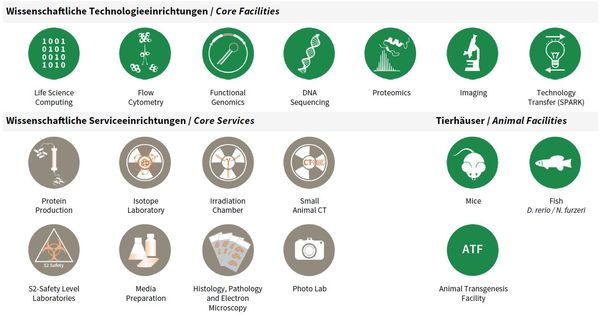Core Facilites and Core Services
At the beginning of 2016, a “core” structure was put into effect that organized facility and service units as independent organizational entities from FLI’s research groups. A number of technology platforms (e.g. sequencing, mass spectrometry) grew out of individual methodological requirements for single research groups in the last years but developed into semiautonomous substructures. As consequence of re-focused research activities and the concomitant advent of new research groups at FLI, those units increasingly had to serve many FLI groups and collaborative research efforts in the Jena research area.
To accommodate this development and to increase efficiency as well as transparency for users, facility personnel and for administrative processes, it came natural to re-organize such activities into independent units as “FLI Core Facilities and Services” and to phase out infrastructures considered non-essential for FLI’s research focus (X-ray crystallography and NMR spectroscopy).
FLI’s Core Facilities (CF) are managed by a CF Manager and are each scientifically guided in their activities and development by an FLI Group Leader, as Scientific Supervisor. The animal facilities comprising fish, mouse and transgenesis are run separately, as they involve a more complex organizational structure. Basic Core Services (CS) are directly led by the Head of Core (HC), who in turn is supported by individual CS Managers.
All facilities and services, including animal facilities, have a valuable contribution to FLI’s research articles; e.g. from 2016–2018, to 54% of all peer reviewed research publications.
Overview Core Facilities and Core Services at FLI.
Publications
(since 2016)
2017
- Tissue-, sex- and age-specific DNA methylation of rat glucocorticoid receptor gene promoter and insulin like growth factor 2 imprinting control region.
Agba OB, Lausser L, Huse K, Bergmeier C, Jahn N, Groth M, Bens M, Sahm A, Gall M, Witte OW, Kestler HA, Schwab M, Platzer M
Physiol Genomics 2017, 49(11), 690-702 APSselect for distinction in scholarship in the Physiological Genomics - Common Fibril Structures Imply Systemically Conserved Protein Misfolding Pathways In Vivo.
Annamalai K, Liberta F, Vielberg MT, Close W, Lilie H, Gührs KH, Schierhorn A, Koehler R, Schmidt A, Haupt C, Hegenbart U, Schönland S, Schmidt M, Groll M, Fändrich M
Angew Chem Int Ed Engl 2017, 56(26), 7510-4 - A miRNA catalogue and ncRNA annotation of the short-living fish Nothobranchius furzeri.
Baumgart* M, Barth* E, Savino A, Groth M, Koch P, Petzold A, Arisi I, Platzer M, Marz* M, Cellerino* A
BMC Genomics 2017, 18(1), 693 * equal contribution - New insights into the operative network of FaEO, an enone oxidoreductase from Fragaria x ananassa Duch.
Collu G, Farci D, Esposito F, Pintus F, Kirkpatrick J, Piano D
Plant Mol Biol 2017, 94(1-2), 125-36 - HMMR acts in the PLK1-dependent spindle positioning pathway and supports neural development.
Connell M, Chen H, Jiang J, Kuan CW, Fotovati A, Chu T, He Z, Lengyell TC, Li H, Kroll T, Li AM, Goldowitz D, Frappart L, Ploubidou A, Patel M, Pilarski LM, Simpson EM, Lange P, Allan DW, Maxwell CA
Elife 2017, 6, e28672 - A new procedure for a fast soft staining of BN-PAGEs on photosynthetic complexes.
Farci D, Kirkpatrick J, Piano D
Electrophoresis 2017, 38(3-4), 441-6 - Transcriptional profiling reveals protective mechanisms in brains of long-lived mice.
Frahm C, Srivastava A, Schmidt S, Mueller J, Groth M, Guenther M, Ji Y, Priebe S, Platzer M, Witte OW
Neurobiol Aging 2017, 52, 23-31 - Characterization of the interaction between the small RNA-encoded peptide SR1P and GapA from Bacillus subtilis.
Gimpel M, Maiwald C, Wiedemann C, Görlach M, Brantl S
Microbiology 2017, 163(8), 1248-59 Editors' Choice - Trifunctional lipid probes for comprehensive studies of single lipid species in living cells.
Höglinger D, Nadler A, Haberkant P, Kirkpatrick J, Schifferer M, Stein F, Hauke S, Porter FD, Schultz C
Proc Natl Acad Sci U S A 2017, 114(7), 1566-71 - Stepwise characterization of non-synonymous mutations in the HSV-1 thymidine kinase gene by different functional assays.
Kaspar M, Bohn-Wippert K, Bellstedt P, Häfner S, Görlach M, Sauerbrei A
J Virol Methods 2017, 247, 51-7









